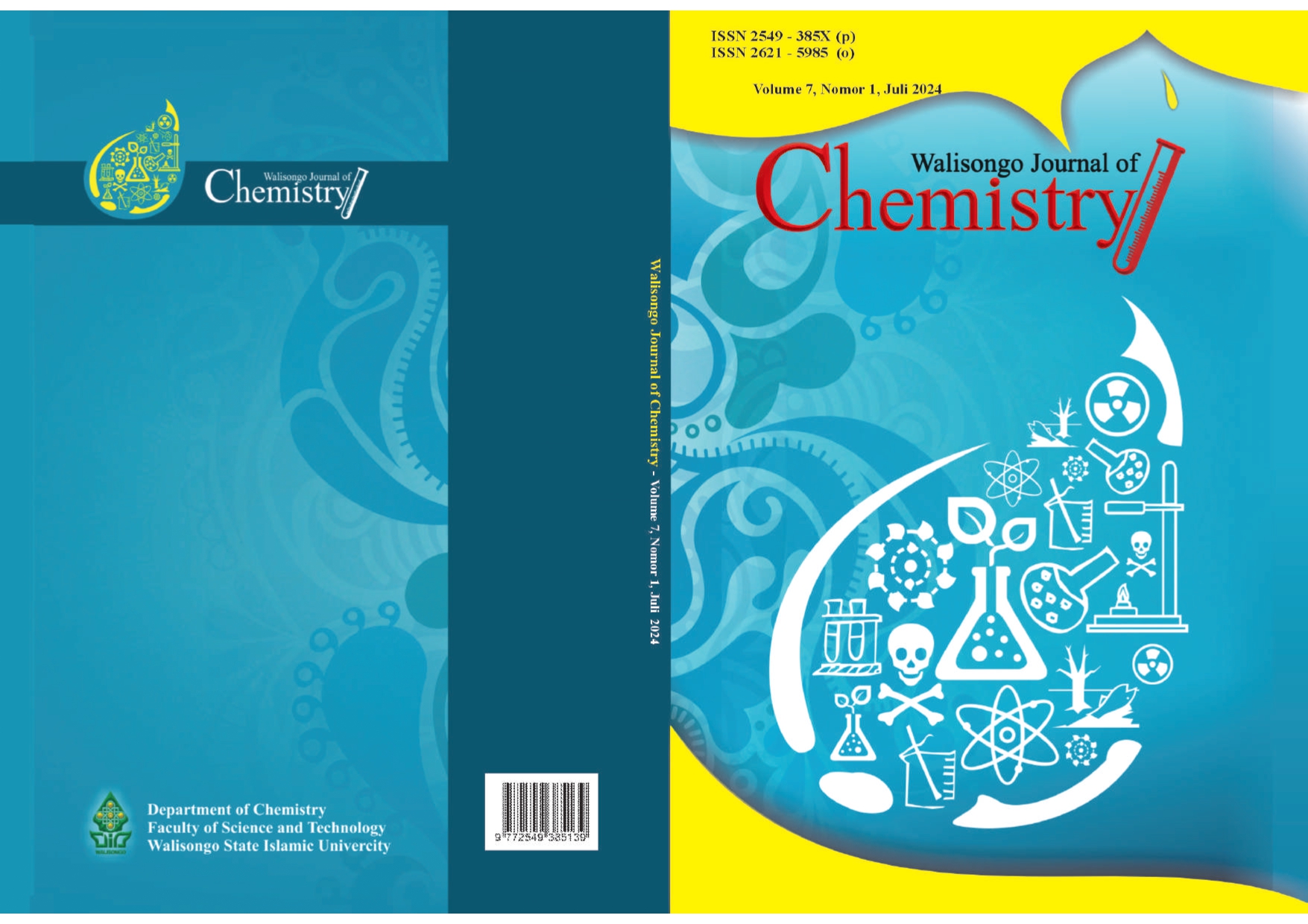Activity Test of Methanol Extract of Young Stem Bark of Semambu rattan Plant (Calamus Scipionum Lour) with DPPH Method
DOI:
https://doi.org/10.21580/wjc.v7i1.17350Keywords:
Semambu Rattan, Antioxidant, IC50Abstract
The Semambu rattan (Calamus scipionum Lour) plant contains phenolic compounds, such as flavonoids and polyphenols that have the ability as antioxidants. Therefore, the community often consumes C scipionum Lour, and the stiff stems are made of crafts. However, the skin, the content of which is not scientifically known, is currently considered a waste in the community. This study was conducted to determine the results of phytochemical tests and the activity of methanol extract of young bark of the Semambu rattan plant (C. scipionum Lour). The bark of young Semambu rattan stems is extracted by maceration, and then the extract obtained is carried out by phytochemical screening. Antioxidant acrypability was measured using the DPPH method at a wavelength of 517nm. The results of phytochemical testing of young bark extract of C. scipionum Lour contain flavonoids, saponins, tannins, alkaloids and terpenoids. The research results on antioxidant young stem bark C. scipionum Lour with positive control in the form of ascorbic acid obtained results IC50 = 65.10 ppm, which is classified as a potent antioxidant. The conclusion of this study is that the extract of the young bark of Semambu rattan (C. scipionum Lour) can be used as an alternative antioxidant.Downloads
References
Abror Rahman. (2020). Isolasi, Karakteristik, dan uji antioksidan Senyawa Turunana Kuersetin dari kulit batang Melicope Quercifolia. Jurnal Sains Dan Kesehatan, 2(1), 242–247.
Cahyaningsih, E., Yuda, P. E. S. K., & Santoso, P. (2019). Skrining Fitokimia dan Uji Aktivitas Antioksidan Ekstrak Etanol Bunga Telang (Clitoria ternatea L.) Dengan Metode Spektrofotometri UV-Vis. Jurnal Ilmiah Medicamento, 5(1), 51–57. https://doi.org/10.36733/medicamento.v5i1.851
Damanis, F. V. M., Wewengkang, D. S., & Antasionasti, I. (2020). Uji Aktivitas Antioksidan Ekstrak Ascidian Herdmania Momus Dengan Metode DPPH (1,1-difenil-2-pikrilhidrazil). Pharmacon, 9(3), 464. https://doi.org/10.35799/pha.9.2020.30033
Fatimah, S. (2022). Kandungan Metabolit Sekunder Daun Muda dan Daun Dewasa Tumbuhan Keji (Staurogyne elongata [Blume] Kuntze) di Kabupaten pekalongan, Skripsi.
Fendri, S. T. (2021). Uji Aktivitas Antioksidan Ekstrak Buah rotan ( Calamus sp) Dengan Menggunakan Menggunakan Metode DPPH. 6(2), 223–232.
Fendri, S. T. J., Verawati, V., Putri, A., & Ferilda, S. (2022). Penentuan Kadar Fenolat Total dan Uji Aktivitas Antioksidan dari Ekstrak Non Polar, Semi Polar dan Polar Buah Rotan (Calamus manan). Jurnal Farmasi Higea, 14(1), 58. https://doi.org/10.52689/higea.v14i1.442
Fitri Yani, D., & Dirmansyah, R. (2021). Uji Aktivitas Fraksi Metanol dan N-Heksan Kulit dan Kernel Biji Kebiul (Caesalpinia bonduc L.) sebagai Tabir Surya. Jurnal Sains Dasar, 10(1), 1–5. https://doi.org/10.21831/jsd.v10i1.39065
Handoyo, D. L. Y. (2020). The Influence Of Maseration Time (Immeration) On The Vocity Of Birthleaf Extract (Piper Beetle). Jurnal Farmasi Tinctura, 2(1), 34–41. https://doi.org/10.35316/tinctura.v2i1.1546
Jasni. (2007). Atlas Rotan Indonesia Jilid 1. 2.
Ketapang, K., Trianawati, F., Tavita, G. E., & Oramahi, H. A. (2021). Pemanfaatan Tumbuhan Kayu Hasil Hutan dan Bukan Kayu Oleh Masyarakat Mekar RAya Kecamatan Simpang Dua Kabupaten Ketapang. 9, 661–678.
Maesaroh, K., Kurnia, D., & Al Anshori, J. (2018). Perbandingan Metode Uji Aktivitas Antioksidan DPPH, FRAP dan FIC Terhadap Asam Askorbat, Asam Galat dan Kuersetin. Chimica et Natura Acta, 6(2), 93. https://doi.org/10.24198/cna.v6.n2.19049
Mayasari, U. (2022a). Uji Aktivitas Antibakteri ekstrak Batang Muda Rotan Manau (Calamus manan) terhadap pertumbuhan bakteri Klebsiella pneumonia. Klorofil: Jurnal Ilmu Biologi Dan Terapan, 6(1), 9. https://doi.org/10.30821/kfl:jibt.v6i1.11762
Mayasari, U. (2022b). Uji Aktivitas Antibakteri ekstrak Batang Muda Rotan Manau (Calamus manan) terhadap pertumbuhan bakteri Klebsiella pneumonia. Klorofil: Jurnal Ilmu Biologi Dan Terapan, 6(1), 9. https://doi.org/10.30821/kfl:jibt.v6i1.11762
Nur’amala, putri irma. (2019). Uji Aktivitas Antioksidan Ekstrak Etanol Buah Kecipir (Psophocarpus tetragonolobus L) Dengan Metode DPPH (1,1-Diphenyl-2-Picrylhidrazyl). Jurnal Matematika Dan IPA, 1(1), 26–33.
Putra, H. A. D. (2021). Analisis Besei (Fe) dan Kalsium (Ca) Dalam Ekstrak Etanol BUah Rotan (Calamus sp) Dengan Mengunakan Spektrofotometri Serapan Atom (SSA).
Putri & Hidajati. (2015). Uji Aktivitas Antioksidan Senyawa Fenolik Ekstrak Metanol Kulit Batang Tumbuhan Nyiri Batu (Xylocarpus moluccensis). Unesa Journal of Chemistry, 4(1), 1–6. https://jurnalmahasiswa.unesa.ac.id/index.php/unesa-journal-of-chemistry/article/viewFile/10820/10386
Putu, N. (2021). Kajian Pengaruh Pelarut Terhadap Aktivitas Antioksidan Alga Coklat Genus Sargassum dengan Metode Dpph. 3(2), 201–213. http://e-abdimas.unw.ac.id/index.php/jhhs/article/download/80/69/
Rantina, P., Yani, D. F., Sari, S. P., & Raihan, D. (2022). Phytochemical Screening and Larvicidal Activity of Kebiul (Caesalpinia Bonduc. L) Seed Kernel Against Aedes Aegypti Mosquito. Walisongo Journal of Chemistry, 5(1), 59–66. https://doi.org/10.21580/wjc.v5i1.9476
Salusu, H. D., Aryani, F., Zarta, A. R., Budiarso, E., Kusuma, I. W., & Arung, E. T. (2018). Antioxidant Assay of the Ethanolic Extract of Three Species of Rattan Fruits using DPPH Method. Journal of Tropical Pharmacy and Chemistry, 4(4), 154–162. https://doi.org/10.25026/jtpc.v4i4.170
Simanjuntak, E. J., & Zulham, Z. (2020). Superoksida Dismutase (Sod) Dan Radikal Bebas. Jurnal Keperawatan Dan Fisioterapi (Jkf), 2(2), 124–129. https://doi.org/10.35451/jkf.v2i2.342
Solichah, A. I., Anwar, K., Rohman, A., & Fakhrudin, N. (2021). Profil Fitokimia dan Aktivitas Antioksidan Beberapa Tumbuhan Genus Artocarpus di Indonesia. Journal of Food and Pharmaceutical Sciences, 9(2), 443–460. https://doi.org/10.22146/jfps.2026
Wahdaningsih, S. (2022). Uji Aktivitas Antioksidan Ekstrak Etanol dan Fraksi N-Heksan Kulit Buah Naga Merah (Hylocereus polyrhizus). Jurnal Pharmascience, 9(2), 176. https://doi.org/10.20527/jps.v9i2.13135
Downloads
Additional Files
Published
How to Cite
Issue
Section
License
The copyright of the received article shall be assigned to the publisher of the journal. The intended copyright includes the right to publish the article in various forms (including reprints). The journal maintains the publishing rights to published articles.
In line with the license, authors and any users (readers and other researchers) are allowed to share and adapt the material. In addition, the material must be given appropriate credit, provided with a link to the license, and indicated if changes were made. If authors remix, transform or build upon the material, authors must distribute their contributions under the same license as the original.









